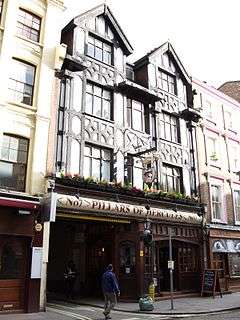Manette Street


Manette Street is a small street in the Soho area of London, linking the Charing Cross Road to Greek Street. Dating from the 1690s,[1][2] and formerly named Rose Street, it is now named after the fictional character of Dr Manette in Charles Dickens' A Tale of Two Cities.[2] Buildings on the street include the Foyles Building and the Pillars of Hercules pub, and Goldbeater's House, which still has an arm-and-hammer sign outside it, a replica of the original described by Dickens in A Tale of Two Cities.[1] The House of St Barnabas has a chapel and garden facing onto Manette Street, and an entrance to The Borderline nightclub is accessed from Manette Street.
The street was associated with anarchism in the 19th century,[3] in particular in association with the Rose Street Club, known for its popularity with radicals of all nationalities.[4]
References
- 1 2 Hibbert, Christopher; Weinreb, Ben (2010). The London Encyclopaedia (3rd Edition). Macmillan. p. 524. ISBN 9781405049252.
- 1 2 "Greek Street Area: Portland Estate, Manette Street". British History Online. Retrieved 2016-09-08.
- ↑ "Manette Street, Soho – once known as Rose Street, an anarchist hot-bed of the late 19th century – Anarchy in the UK – No Future: The Great Anarchist Scare, Terror Through Time – BBC Radio 4". BBC. Retrieved 2016-09-08.
- ↑ Matthew James Thomas (July 1998). "Paths to Utopia: Anarchist Counter-Cultures in Late Victorian and Edwardian Britain 1880–1914" (PDF). University of Warwick. Retrieved 2016-09-08.
External links
- View down Manette Street from the Greek Street end
- View of entry to Greek Street from the Manette Street end
Coordinates: 51°30′53″N 0°07′50″W / 51.51475°N 0.13050°W